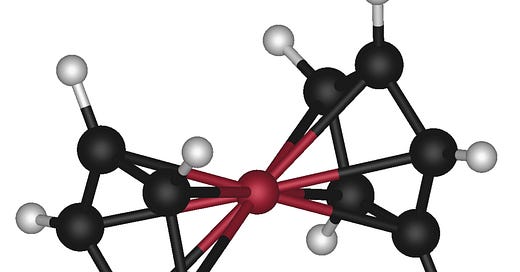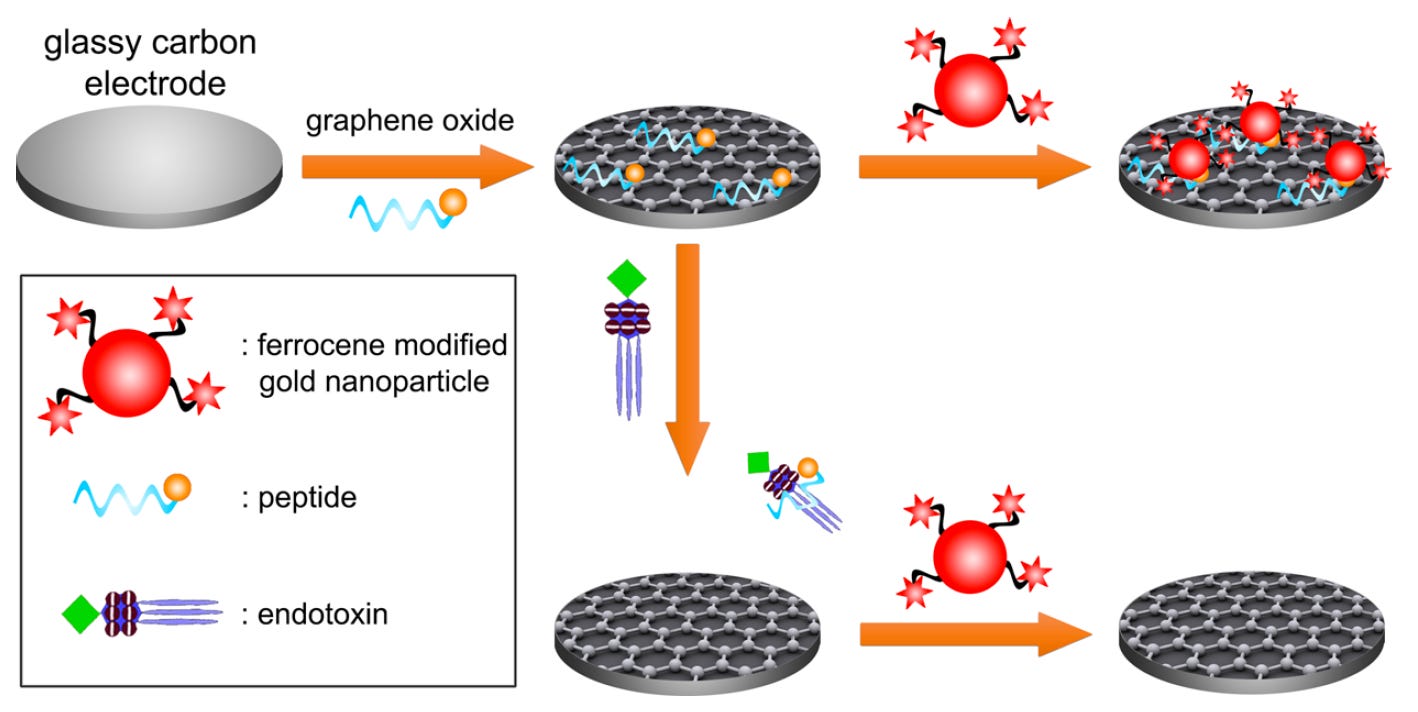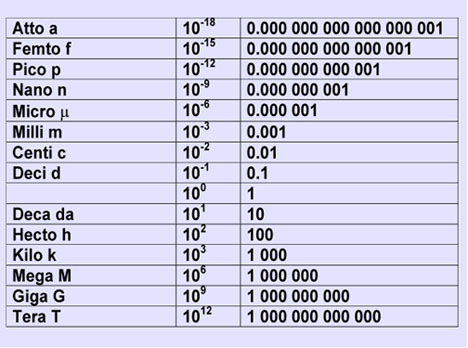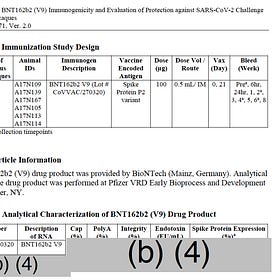Graphene Oxide, Gold and Organometallic Ferrocene make sensitive Endotoxin Detector
As a former organometallic chemist, I appreciate the advances made in electronic sensors that can detect Pfizer jab Endotoxin at Femtogram levels.
In 1980 I had the pleasure of meeting Nobel Prize winner Professor Sir Geoffrey Wilkinson1 who made Ferrocene, a “sandwich molecule”, where two carbon pentagons bond to an Iron atom. Wilkinson was a supervisor of my PhD supervisor Ron Dickson. I had made Ferrocene as an undergraduate experiment and went on to make new similar molecules of the Platinum Group metals in my postdoctoral appointments. Wilkinson’s creation turned chemical bonding theory on its head.
Each Carbon atom bears a Hydrogen atom.
Functional Derivatives of Ferrocene
What has this to do with Pfizer Endotoxins, you ask?
Be patient, I am getting around to that.
It was soon found that Hydrogen atoms on Ferrocene could be replaced with functional groups that allow an unlimited number of useful air stable derivatives to be made. Here is a “one-pot” synthesis that can be applied on an industrial scale.
Note the 200 gram with exclamation mark.2
Polypeptides added to Ferrocene
Today, I am interested in clever attachment to Ferrocene of a string of amino acids terminating in a Sulfur atom with a Hydrogen atom available for further chemistry.
In 2019, Chinese scientists, seeking to make a new detector to replace the use of Horsehoe Crab Blood Limulus Amoebocyte Lysate (LAL) assay, made Gold Nanoparticles which bond to the Sulfur atom of 5′-ferrocene-TCCATGTACCTT-3′ SH.3
Making the Graphene Oxide Endotoxin Sensor
The clever joining of technology is displayed in this scheme by Yu et al.
They took Glassy Carbon, coated it in Graphene Oxide, soaked it in a solution of the Ferrocene Peptide and measured the electrical signal. Then they attached Gold Nanoparticles to the surface bound Ferrocene Peptide and measured the electronic signal gain. When they added Endotoxin it displaced the Ferrocene Peptide Gold nanoparticles, changing the signal yet again. The surface reaction was highly selective, allowing detection limit of 0.001 Endotoxin Units (EU) per millilitre. Compare that with the 12.5 EU “allowed” as a residual contaminant in Pfizer jabs.4
Detection of Femtogram quantities or less of Endotoxin is the current goal in biochemistry.5
Credits
I would not have learned about this organometallic Endotoxin sensor if I had not followed a trail leading from my friend Canceled Mouse6, whose Tweets I can see but not respond to due to my life ban on Twitter. From there I discovered that in September 2022 Jonathan Weissman gave a lecture highlighting the Endotoxin hazard in Pfizer jabs where he gave links to literature references.7
Note that Jonathan Weissman’s Youtube video is being intercepted by the Australian government at taxpayer expense. He is obviously regarded as “dangerous”.8
Thanks to Julian Gillespie for finding a very useful review9 of modern sensor methods used to detect Endotoxins.
Pfizer will not release its Batch Endotoxin assays
A friend made since my account has been restored on Twitter pointed me toward a very nice review of methods used to measure Endotoxin published in 2021.10
It points out that the Horseshoe Crab assay is capable of measuring Endotoxin levels as small as 0.001 EU/ml. Which means that Pfizer or TGA reports which state NMT (No More Than) 1.0 EU/ml or 5 EU/ml are nowhere near accurate enough to allow us to compare relative levels of harms and Deaths caused by various Lots or Batches.
October 2023 Update
Looking for alternative methods of Endotoxin meausrement, Radhika11 and coworkers used a fluorescent dye method but its detection limit was high at 0.1 ng/ml.
Interesting that Kevin McKernan used the same dye in his studies of DNA contamination in Covid19 jabs.12
https://en.wikipedia.org/wiki/Geoffrey_Wilkinson
Petrov AR, et al. 2013. Large-Scale Preparation of 1,1′-Ferrocenedicarboxylic Acid, a Key Compound for the Synthesis of 1,1′-Disubstituted Ferrocene Derivatives. https://pubs.acs.org/doi/full/10.1021/om4004972
Yu N, et al. 2019. Highly Sensitive Endotoxin Assay Combining Peptide/Graphene Oxide and DNA-Modified Gold Nanoparticles. https://pubmed.ncbi.nlm.nih.gov/31508556/
Extreme Toxicity of Endotoxins in Pfizer Jabs
How much Endotoxin is in the Pfizer Jabs? Perhaps we should ask Dr Jordon T Walker, Pfizer executive in charge of corporate strategy for expanding use of mRNA. See the 17 February 2023 update below. Despite US Court order, the document released by Pfizer on its jab testing with Rhesus Macaques using drug product made by BioNTech in Germany and imported to…
https://twitter.com/canceledmouse
https://www.alltherisks.com/
https://twitter.com/W777Jonathan
Sondhi P, et al. 2020. Nanomaterials for Biosensing Lipopolysaccharide. https://www.ncbi.nlm.nih.gov/pmc/articles/PMC7168309/
Endotoxin contamination of engineered nanomaterials: Overcoming the hurdles associated with endotoxin testing https://wires.onlinelibrary.wiley.com/doi/10.1002/wnan.1738
Radhika NK, et al. 2021. A rapid aptamer-based fluorescence assay for the detection of lipopolysaccharides using SYBR Green I. https://analyticalsciencejournals.onlinelibrary.wiley.com/doi/10.1002/bio.4104








You , sir , are brilliant ! Thank you for your posts !
If I understand well, this means that the graphene oxide was added diliberately and not by accidental contamination as pfizer tried to sell us